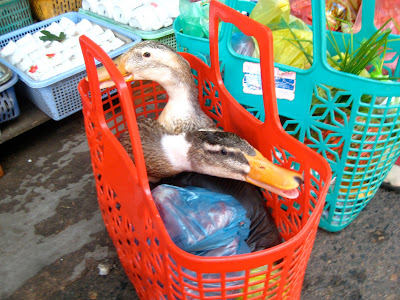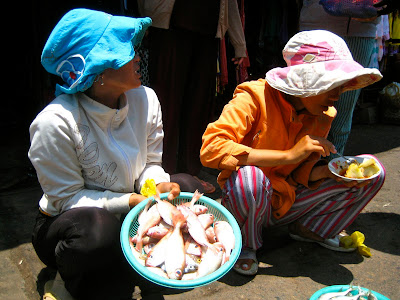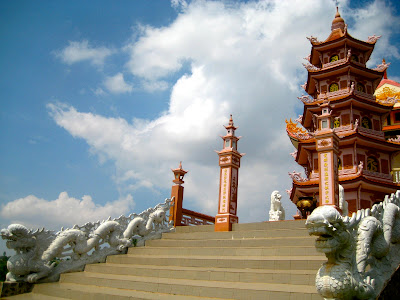I know I haven't showered in a while and don't smell fantastic. I also know my travel beard is beginning to look like a secret garden made of less-desirable nether hair. But all that said, this ostrich is being overly melodramatic with this suicide attempt. First of all, shoving her long furry gray neck into a crevasse in the wooden gate is never going to work. It's definitely not sharp enough and her trainer is way too fast. Secondly, she doesn't smell that great either and she looks positively ridiculous with her head stuck in the gate, feathered black and white body flailing behind. Stop being a drama queen, ostrich. I know it is unfortunate that your young trainer never honored you with a name, but it's reason for a suicide attempt.
I'm hiking through Fairy Canyon in Mui Ne, Vietnam when I stumble upon this random ostrich farm like an oasis in the desert. Funny, I had no idea they had ostriches in Vietnam. I climb up a flight of stairs and sit on "No Name" the ostrich who must be seven feet tall, with gray hair covering her face and neck and a beard. I sit on a saddle while the trainer follows behind, ensuring No Name doesn't throw me off. The ostrich is lightning fast and I really wish I could ride her around town instead of my motorbike. You know what they say, wing-ostriches get all the women. The ride is rocky and unstable and I'm convinced I'm going to fall off every second. Well if you're going to break an arm, ostrich riding sure makes a good story.
From the ostrich ride, I continue through Fairy Stream, a small ravine running through the center of tall red clay bluffs. As with most outdoor excursions in Southeast Asia, my tour guides are two small eight year-olds who grab my hand and eagerly take me around the site. The stream is hidden off a small road in Mui Ne, past several garbage dumps and an outdoor clay pottery store. It begins as a shallow stream surrounded by lush jungle and opens up a few minutes later into large clay cliffs in shades of copper, tan, red, and yellow. The colors blend together to create vivid gradients in the clay, different shades dripping into one another, bringing to mind prehistorical cave art. As the cliffs are made of soft sand and clay, the material is constantly cascading down the cliffs creating ad hoc mud foot spas on the edge of the creek. My young guides and I giddily prance through the mud, recharging the joints in our ankles and heels.
***
I arrive in Mui Ne in the middle of the night. Although the town is a popular beach resort, at 3am it's positively desolate. All the hotels have closed up shop, locking gates in front of their entrances. I peruse the streets searching for anyone who is awake and luckily stumble upon one inn keeper who is asleep on a hammock in front of his hostel. I wake him up, quickly agree to the tariff and pass out.
Mui Ne is a beach destination like Nah Trang, but decidedly more quiet and peaceful. The long white sand beach is lined with high-end resorts and restaurants. The town is on the South China Sea whose large waves come violently crashing into the shoreline. While Nah Trang is brimming with backpackers and all night bars, Mui Ne's streets are lined with families and honeymooners. The restaurants close quite early and, during the low season of July, there is basically no nightlife. Although Mui Ne is just one street running along the beach, it is quite sprawling and a car or bike is necessary to get around.
Mui Ne was originally, and still is, a fishing village. However, it began to transform into a tourist area after a 1995 solar eclipse brought thousands to the small, undiscovered beach hamlet. Today, Mui Ne presents a strong juxtaposition between a poor community of fisherman, many of whom struggle daily to earn $500 - $1,000 a year and groups of wealthy Western tourists relaxing at luxury hotels at $100+ a night. Nowhere is this contrast more evident than Phan Thiet fishing village which I visit early in the morning via motorbike. It's only a few miles outside central Mui Ne, straight past all the starred hotels. I arrive to see two dozen men and women in conical hats hunched over in the scorching morning sun unloading mountains of sardines and anchovies from fishing vessels. The South China Sea beyond them is dotted with small rusted fishing boats all competing over the same catch. The workers fill colorful wooden baskets with the tiny silver fish and load them into trucks or onto the back or motorbikes. Some of the fish will be sold in markets while others will be processed into nuoc mam, the salty, aromatic Vietnamese fish sauce that is one of the region's main exports and a national staple on every dinner table. I continue on to Phan Thiet's day market which sells a impressive variety of dragonfruit, one of the region's specialties, in every imaginable hue.
 |
| Phan Thiet fishing village |
 |
| Phan Thiet day market |
 |
| Dragonfruits |
 |
| Dinner tonight |
For me, the highlight of Phan Thiet is a twenty-five meter long whale skeleton, preserved at Thuy Tu Temple. It's the largest in Asia and has become something of a sacred object for many Vietnamese. The brown embalmed skeleton is so massive that it resembles a dinosaur. His fins are the size of VW bugs. This is no ordinary whale; it probably ate Free Willy as its last meal.
Motorbiking along the coast of the South China Sea is quite a thrill. The skies are a vibrant shade of blue, a heavy sea breeze flows through my hair, and the smell of the ocean fills my nose as I bike past. The entire afternoon is spent hugging the shore, garnering sustained views of ivory white sand, palm trees, and crystal blue waters reflecting the sun and the clouds. Although I've never been, I imagine the experience is similar to driving up the Pacific Coast Highway. In a convertible.
On my way back to central Mui Ne, I stop by Po Shanu Cham Tower, built in the 8th Century. As with the previous Cham towers I've seen in Vietnam, Po Shanu is a series of copper-colored domed temples. At Po Shanu, each represents a different element -- earth, air, fire, water. It's the Captain Planet of ancient Cham temples. The neighboring pagoda offers beautiful views of the Phan Thiet Harbor and the city's main cemetery, with hundreds of rows of tombstones in every color of the rainbow.
I'm starving so I pull over at a small series of food stands. One immediately catches my eye, even though I'm sprinting through town at 60MPH on a high-powered scooter. The older lady's tiny cart looks like a transformed popcorn machine. But instead of corn kernels, the inside of the glass case is filled with mahogany-colored hanging ducks which have been roasted and covered in honey. I order half a roasted duck, chopped with a cleaver and placed in a bowl alongside hoisin sauce, scallions, pickled daikon and carrots. It's not the meatiest duck, but the what the limited flesh is quite succulent and the entire dish is quite delicious -- almost a deconstructed Peking duck with crisp, cracker-like skin. Plus the pickled vegetables add a nice bright touch to offset the saltiness and sweetness of the bird and hoisin.
Dinner is right on the beach at Lam Tong restaurant, overlooking the South China Sea. The plastic patio tables are positioned right on the sand and I eat barefoot, the sound of the sea providing the soundtrack. The front of the restaurant has two large pools of swimming eels, lobsters, local fish, and crabs. My appetizer is five large grilled shrimp that I devour, head and all. Mains are a large filet of local white fish rubbed with chilis and tamarind and a hot pot of roasted tofu and pineapple.















































No comments:
Post a Comment